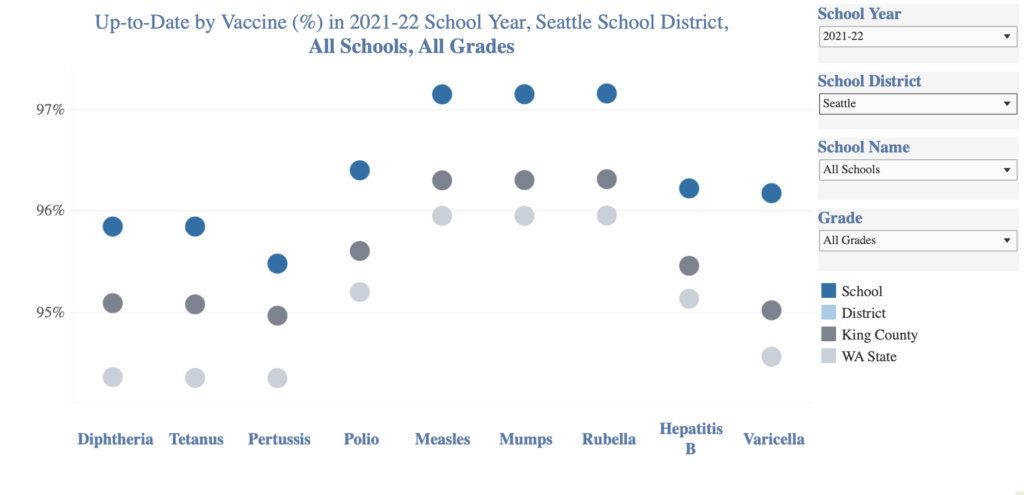Debra Berliner, Public Health – Seattle & King County
What percentage of children in your child’s school are vaccinated against measles? How does your school district compare to others in King County? How have student immunization rates changed over the course of the COVID-19 pandemic? Find this and more on Public Health’s School Immunizations Data Dashboard, recently updated to include data for the 2021-22 school year.
Using interactive data visualizations, you can view local school, school district, county, and state immunization completion and exemption data. Find:
- Vaccination completion and exemption trends over time.
- Percentage of students who are up-to-date on vaccinations, out-of-compliance (i.e. overdue), conditional (i.e. making progress toward full immunization), and exempt (have opted out of one or more vaccinations for personal, religious, or medical reasons).
- Common reasons students file exemptions.
- How vaccination coverage varies for each school in a district.
- How public and private schools compare on immunization coverage.

Some high-level takeaways:
- Across King County, immunization rates for K-12 students increased from 88% in the fall of 2016 to 92% in the fall of 2019. During the pandemic, overall K-12 rates held steady, and remained at 92% in the fall of 2020 and the fall of 2021.
- A more focused look at specific grade levels tells a slightly different story.Kindergarten and seventh grade immunization rates increased from fall 2016 to fall 2019, but declined somewhat during the pandemic. In the fall of 2019, 92% of kindergartners were up-to-date on vaccinations compared to 90% in 2021. Seventh grade rates fell from 90% to 86% over the same time period.
- Immunization rates vary considerably by school district. Tahoma (95%), Renton (94%), and Issaquah (94%) school districts had the highest coverage among K-12 students overall in fall 2021. Skykomish (80%), Vashon (85%), and Bellevue (86%) had the lowest. During the pandemic, Bellevue, Issaquah, Mercer Island, and Riverview school districts saw the most significant overall declines, while Vashon, Northshore, and Auburn school districts experienced the greatest increases in coverage.
- Fewer students have filed vaccine exemptions in recent years. Three percent of K-12 students claimed exemptions in 2021, down from 5% in 2016.
- We have a bit of catching up to do to prevent a measles outbreak. Ninety-six percent of kindergarteners had received two doses of the MMR (measles, mumps, and rubella) vaccine in the fall of 2019, up from 91% in the fall of 2016. But that number dipped slightly during the pandemic to 94% – just under the 95% threshold needed to achieve herd immunity.
Why are immunizations required for school?
High immunization rates protect our communities from diseases like measles, mumps, and pertussis (aka whooping cough) that can easily circulate in schools. Just a plane ride away in Columbus, Ohio, public health officials are currently battling a measles outbreak with more than 80 cases and over 30 hospitalizations, all in under-vaccinated or unvaccinated children.
Pockets of under-immunization leave communities, including those here in King County, vulnerable to outbreaks. When everyone who can get vaccinated does, it’s a double win: each vaccinated person gets protection directly, and together, we prevent the spread of disease to babies, elders, and those too sick to vaccinate.
What immunizations are required for school?
Vaccines required for school protect children from nine different serious diseases. A child can meet the requirements by showing evidence of immunity from past infection or by getting the required vaccines, including:
- DTaP for kindergarten/Tdap for seventh grade (protects against diphtheria, pertussis, tetanus)
- Hepatitis b
- MMR (protects against measles, mumps, rubella)
- Polio
- Varicella (also known as chickenpox)
Find immunization charts for school in 16 different languages.
How are school immunization data collected?
Children entering school, child care, or other early learning programs are required to have certain vaccinations. Before the first day of school, parents and guardians need to provide documentation of immunization or proof of immunity to specific diseases. Immunization requirements apply to all enrolled children, including those learning remotely.
Schools are required to report their students’ immunization status every year to the Washington State Department of Health (DOH). DOH uses this information to track trends and changes in childhood immunization rates over time and to keep health care partners and community members informed.
Where can I find more information on school and child care immunizations in Washington State?
Visit DOH’s School and Child Care Immunization webpage for a complete description of requirements and links to resources. Parents and guardians, check out this newly launched page for you: School and Child Care Immunizations Information for Families.
Originally published January 12, 2023


